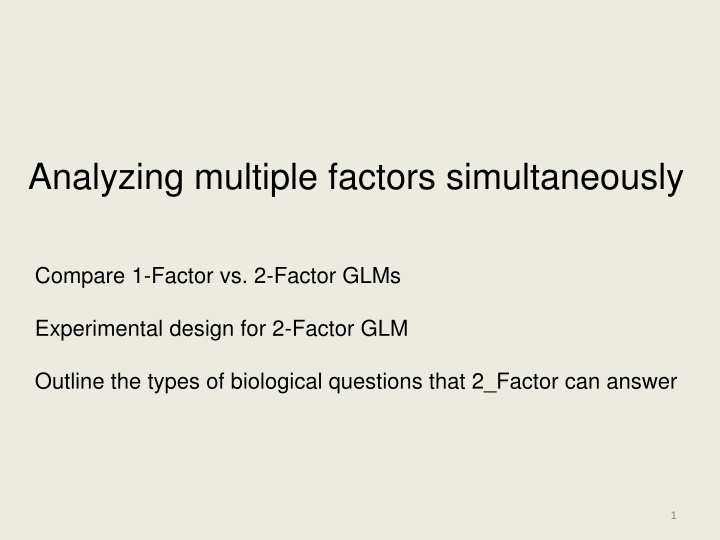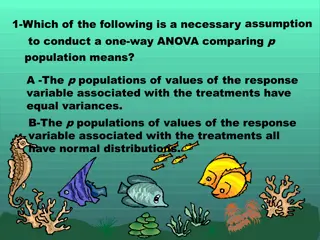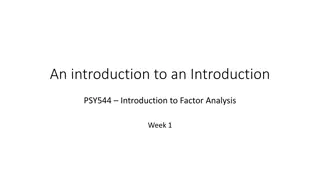Analyzing Experimental Design with One-Factor and Two-Factor GLMs
Comparing the experimental designs of one-factor (1-way ANOVA) and two-factor GLMs, this content explores biological questions that can be answered through the analysis of multiple factors simultaneously in experiments. It discusses sample sizes, drug treatments, factor levels, and concentration variations in the context of independent growth rate measurements. The presentation also delves into perspectives on conducting small vs. large experiments and examines the impact of different factors on the outcomes.
Download Presentation

Please find below an Image/Link to download the presentation.
The content on the website is provided AS IS for your information and personal use only. It may not be sold, licensed, or shared on other websites without obtaining consent from the author.If you encounter any issues during the download, it is possible that the publisher has removed the file from their server.
You are allowed to download the files provided on this website for personal or commercial use, subject to the condition that they are used lawfully. All files are the property of their respective owners.
The content on the website is provided AS IS for your information and personal use only. It may not be sold, licensed, or shared on other websites without obtaining consent from the author.
E N D
Presentation Transcript
Analyzing multiple factors simultaneously Compare 1-Factor vs. 2-Factor GLMs Experimental design for 2-Factor GLM Outline the types of biological questions that 2_Factor can answer 1
We have learned an approach to analyze experiments like this: Sample size Drug Drug A Drug B Drug C xxxxxxxxxx xxxxxxxxxx xxxxxxxxxx x= a randomly selected individual experiencing a treatment = yields an independent growth rate measurement; sample size = 10 per treatment 2
We have learned an approach to analyze experiments like this: Sample size Drug Drug A Drug B Drug C Factor xxxxxxxxxx xxxxxxxxxx xxxxxxxxxx levels x= a randomly selected individual experiencing a treatment = yields an independent growth rate measurement; sample size = 10 per treatment 3
One factor design; loosely called 1-way ANOVA Sample size Drug Drug A Drug B Drug C Factor xxxxxxxxxx xxxxxxxxxx xxxxxxxxxx levels x= a randomly selected individual experiencing a treatment = yields an independent growth rate measurement; sample size = 10 per treatment 4
Imagine we also want to examine drug concentration Multiple small experiments vs. One large experiment? Concentration Drug A XXXXX XXXXX B XXXXX XXXXX C XXXXX XXXXX Low High Low High Low High 5 all in a day s work by Dawn Huczek is licensed CC BY 2.0
Perspective 1 on this experiment One factor Treatment A.Low B.Low C.Low A.High B.High C.High n XXXXX XXXXX XXXXX XXXXX XXXXX XXXXX Factor levels x = a randomly selected individual experiencing a treatment = an independent measurement sample size = 5 per level 6
Perspective 2 on this experiment Concentration Drug A B C Low XXXXX XXXXX XXXXX High XXXXX XXXXX XXXXX x= a randomly selected individual experiencing a treatment = an independent measurement sample size = 5 per treatment combination 7
Perspective 2 on this experiment Two factors, fully crossed design levels Factor Concentration Factor Drug A B C Low XXXXX XXXXX XXXXX High XXXXX XXXXX XXXXX levels x= a randomly selected individual experiencing a treatment = an independent measurement sample size = 5 per treatment combination 8
Perspective 2 on this experiment Two factors, fully crossed design levels Factor Concentration Factor Drug A B C Low XXXXX XXXXX XXXXX High XXXXX XXXXX XXXXX levels x= a randomly selected individual experiencing a treatment = an independent measurement sample size = 5 per treatment combination 9
1-Factor vs. 2-Factor approaches for fully-crossed design Treatment A.Low B.Low C.Low A.High B.High C.High Concentration n XXXXX XXXXX XXXXX XXXXX XXXXX XXXXX Drug A B C Low XXXXX XXXXX XXXXX High XXXXX XXXXX XXXXX The best approach depends on the question your experiment aims to answer. But, questions that are best answered by a 1-Factor analysis are unlikely to lead to a fully-crossed design. 10
What questions can a fully-cross factored design answer? Concentration Drug A B C Low XXXXX XXXXX XXXXX High XXXXX XXXXX XXXXX Does Drug type, irrespective of Concentration, affect the measurement? Does Concentration, irrespective of Drug type, affect the measurement? Does any effect of Drug on the measurement depend on Concentration (and vice versa)? Commonly expect interactions in biology. e.g., does a drug affect sexes differently? Does a gene s effect on survival depend on environment? 11
Take-home messages for analysis of fully cross-factored designs Similarities between 1-Factor and multi-Factor analyses: Approach to analysing these designs can be very similar Similar assumptions and methods to check them We will teach by example - new ideas to watch out for: Multiple factors introduce additional options to calculate SS (not addressed here); use new command, Anova(), to calculate p-values Interactions Can address many hypotheses (e.g., post-hoc tests) that depend an experiment s goals; we cannot illustrate all possibilities. We will illustrate some examples. 12























